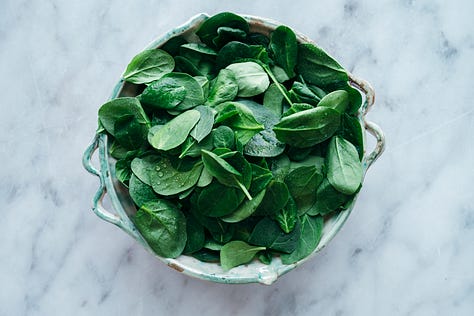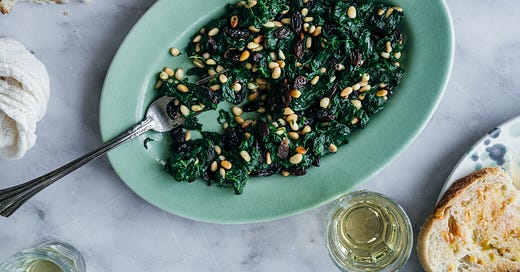Espinacs a la Catalana (Vegan)
A medieval recipe of spinach, raisins and pine nuts that Catalans still enjoy today
Recipes that combine raisins and pine nuts harken back to medieval times, when it was common to blend sweet and savory flavors in meals. Many of those combinations are no longer used but some dishes have managed to remain current. The earthiness of spinach mixed with the richness of pine nuts and the sweetness of raisins is so typically Catalan that this dish is known as Espinacs a la Catalana, Spinach Catalan-style.
Indigenous people would have already been eating pine nuts as the whole Mediterranean basin is teeming with pine trees. Vineyards and their fruits arrived to the region we now know as Catalonia with the Phoenicians, and were largely cultivated within the Greek colonies afterwards. Spinach is originally from Western Asia and was farmed by the Persians who expanded it to other territories.
Spinach became a popular vegetable in the Arab Mediterranean and arrived to the Iberian Peninsula around the 12th century. The first recipe of spinach and raisins is found in a classic Catalan cookbook called Llibre del Coch (1520), by Rupert de Nola, member of the court of the Aragón Crown.
De Espinachs capolats.
Pren espinachs e fes los bells e apres fes los perbullir en aygua e sal / e quant sien ben perbullits pren los entre dos talladors / e apres capolar los as molt be / e apres soffregiras los ab oli de carn salada / e com seran ben soffregits met los enla olla e vagen a coure / e metras hi aximateix enla olla bon brou de carn salada e molto que sia bo e molt gras sols la flor que sia dela olla. E si peruentura volies metre en loch del brou let de cabres o de ouelles o sino de ametles pendras la carn salada e tallar las a troços axicom vn dau e metras la enla olla ensemps ab los espinachs segons enlo temps en que seras si hi vols metre formatges frech jau pots fer aximateix com les tallades damundites dela carn salada / empero si ni mets molts nolls hi metes fins que los espinachs sien cuyts de tot met hi aço abans vn poch de fer escudelles e si hi vols metre aximateix panses tendres que sien cuytes be ne pots metre ab los espinachs / e si noy vols metre aquestes coses ni carn salada / ni formatge de Arago rallat / met hi joliuert e menta / aximateix car ja valran mes los espinachs.
Llibre del Coch (1520), by Rupert de Nola
My translation (and my highlight):
Chopped Spinach
Take spinach and wash them well. Then boil them in water with salt. Once they are well boiled, place them between two cutting boards and chop them finely. After that, fry them in salted meat oil until they are well fried. Once they are fried, put them in a pot to cook. Also, add good salted meat broth to the pot, making sure it's rich and fatty—just the broth from the pot itself.
If you prefer, instead of using meat broth, you can use goat’s milk, sheep’s milk, or even almond milk. In that case, take the salted meat and cut it into pieces about the size of a dice, and add it to the pot with the spinach, depending on how long you want it to cook. If you wish, you can also add fresh cheese, cutting it like the salted meat pieces.
However, if you don’t add too many nuts, you can add some before the spinach is fully cooked, like when making a stew. If you want to add anything else, you can also put in tender raisins that have been well cooked, mixing them with the spinach. If you don’t want to add any of these ingredients, neither salted meat nor grated Aragonese cheese, you can just put in some parsley and mint, as they’ll make the spinach taste even better.
From this medieval recipe that mixes herbs, milk, spinach and raisins we get to a version from the 18th century that is much closer to the way Catalans still cook the dish today. And it reminds us that it was a humble, austere meal, eaten during religious observance as it had no meat.
Un plat d’espinachs
Los espinachs, los has de perbullí a poca aygua y, quant sian cuits, los posarás ab una post a escorra y posaràs la cassola al foch ab sal mòlta, oly, alls trinxatas, menta, piñons y pansas y ho faràs sofragir un poch: y tiraràs los espinachs ben trinxats y fes-ho ben sufregir y ja los pots traure a taula, que es plat de penitencia y dejuni.
Llibre de l’Art de Quynar (1787), Fra Sever d’Olot
My translation (and my highlight):
A Dish of Spinach
You need to boil the spinach in a small amount of water, and when they are cooked, place them in a colander to drain. Then, put a pot on the fire with some ground salt, oil, chopped garlic, mint, pine nuts, and raisins, and let everything fry for a little while. After that, add the well-chopped spinach and fry them thoroughly. Once everything is well-fried, you can serve it at the table. This is a dish for penitence and fasting.
Seeing the recipe below you’ll realise how much it still keeps the essence of the old ones. It’s no doubt, a beloved winter combination that encapsulates a long history and is now eaten as a side dish that happens to be 100% vegan!
Ingredients
3.3 lbs (1,5 kg) spinach
2.8 oz (80 g) raisins, soaked
2.8 oz (80 g) pine nuts
Olive oil, enough to stir-fry (about 2-3tbs)
Salt, to taste
Instructions
Cooking time: 20 minutes
Servings: 4
Rinse the spinach leaves thoroughly and discard the stems.
Fill a medium-sized pot with water and a pinch of salt, then bring it to a boil. Add the spinach, gently pushing the leaves down with a wooden spoon. Let it simmer for 5 minutes.
While the spinach is cooking, prepare a bowl of ice water. Once the spinach is done, transfer it to the ice water to help preserve its vibrant color.
Drain the spinach in a colander and press out any excess water. Leave it in the strainer to drain further.
Heat some oil in a non-stick pan. Once hot, add the raisins (drained of any water) and pine nuts. Stir-fry for a few minutes until they begin to brown. Remove them from the pan and set aside, leaving the oil in the pan.
Roughly mash the spinach with a fork to help break it up. Add the spinach to the pan and stir-fry over medium heat. Season with salt to taste.
Add the cooked raisins and pine nuts back into the pan and mix well.
After a couple of minutes, turn off the heat and serve.
¡Bon profit!







Some tips + downloadable card
This dish is really simple to cook and it makes an excellent side dish to fish, meat or an omelet; or a fantastic filling for cannelloni, crepes or quiches.
One tip to consider is to soak the raisins previously for about 30 min to 2h. The water will help plum them back and they will be juicier afterwards.
Keep reading with a 7-day free trial
Subscribe to My Cup of Tea to keep reading this post and get 7 days of free access to the full post archives.










